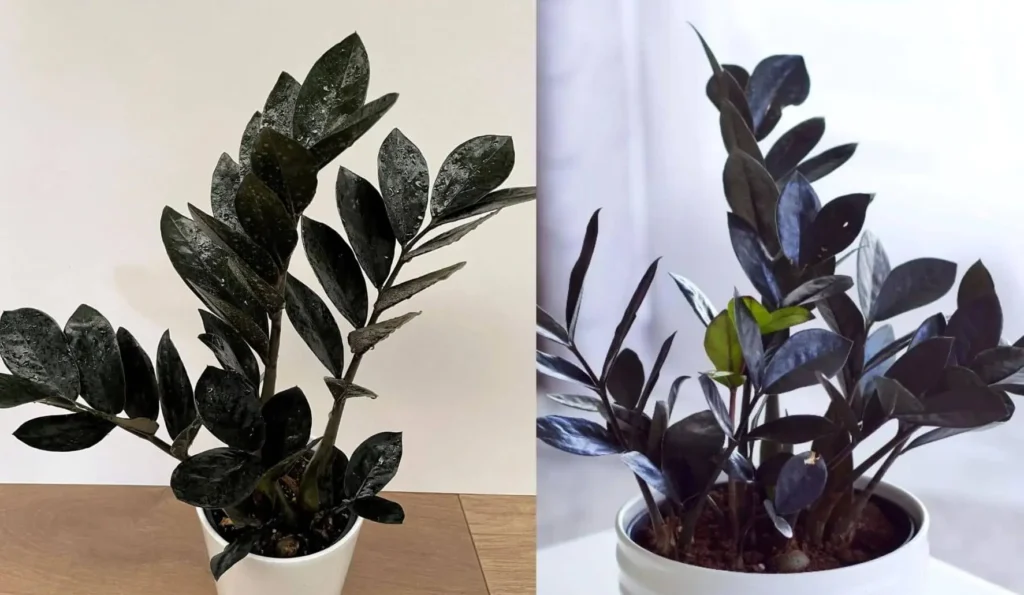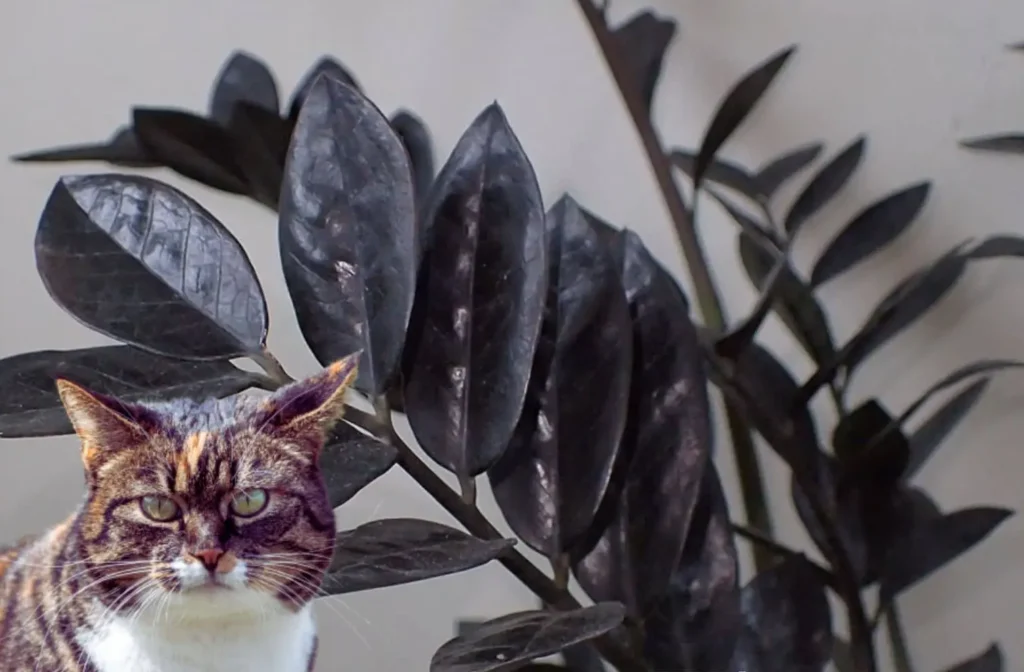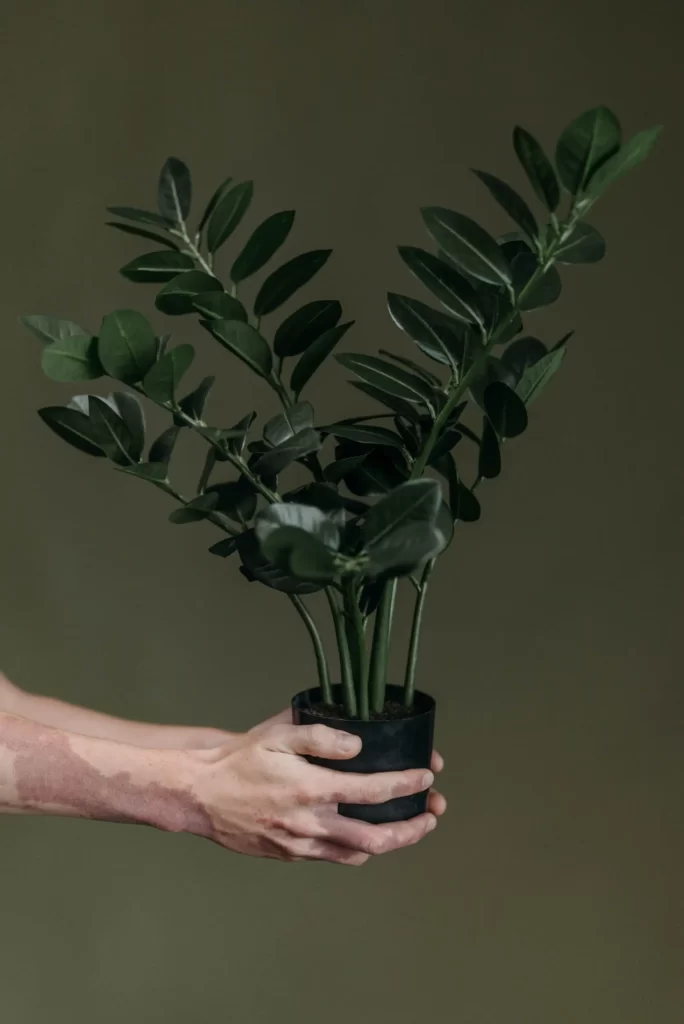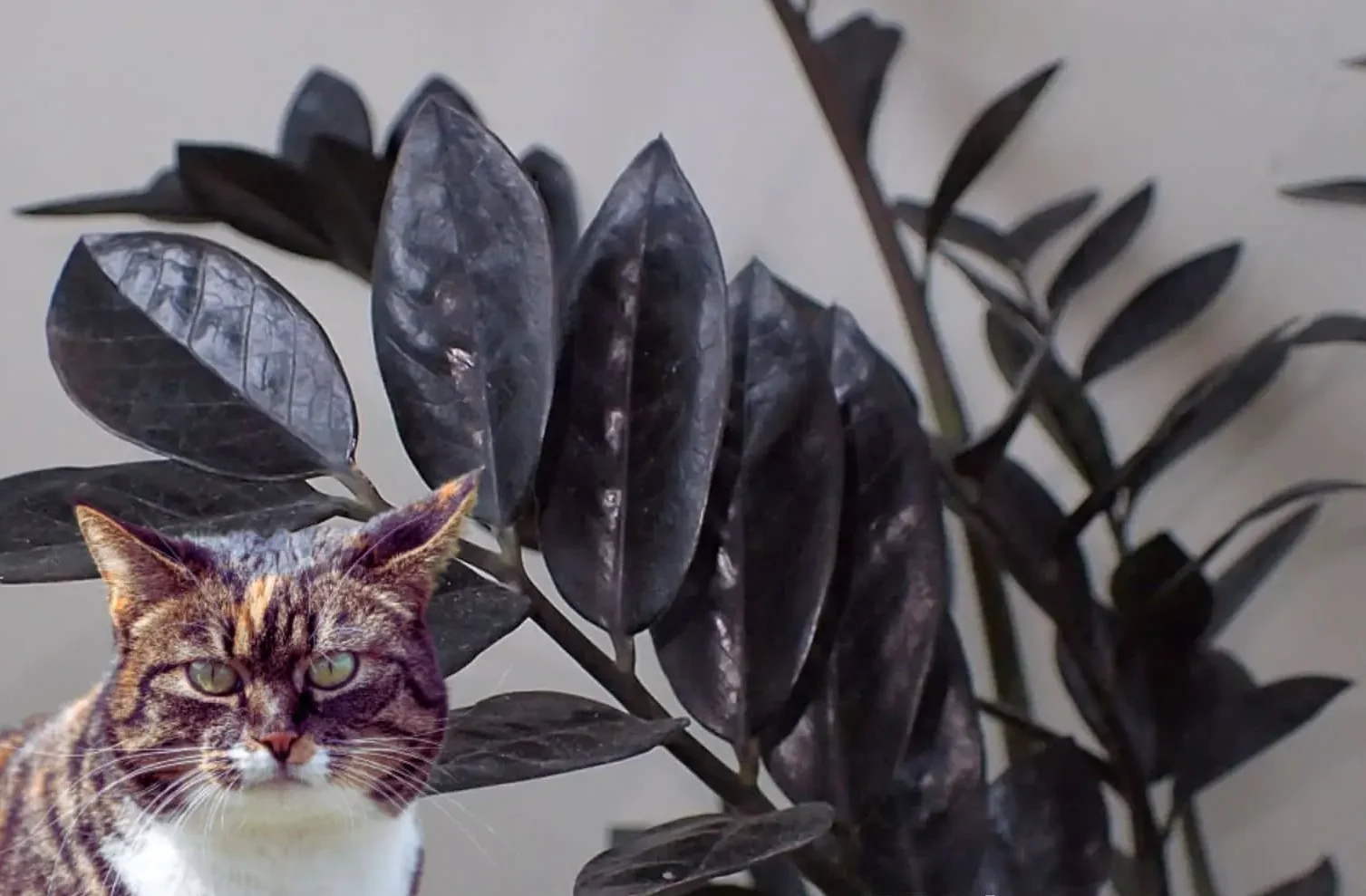Indoor plants can be a wonderful addition to any home, adding beauty and purifying the air. However, it is important to consider the safety of your furry friends when selecting plants.
Raven ZZ plants, also known as Zamioculcas zamiifolia ‘Raven’, have become increasingly popular due to their striking appearance and low-maintenance care. But, are these plants safe for cats?
In this article, we will explore the toxicity of Raven ZZ plants to cats, how to identify symptoms of toxicity, and what to do if your cat ingests the plant.
What are Raven ZZ plants?

Raven ZZ plants are a cultivar of the Zamioculcas zamiifolia plant, which is native to Eastern Africa. They are a member of the Araceae family, which also includes the popular houseplant, the peace lily.
Raven ZZ plants are prized for their dark, almost black, leaves that are glossy and waxy. They are a popular choice for those looking for a striking addition to their indoor plant collection, as they can grow up to three feet tall.
Read: Raven ZZ Plant: Everything You Have To Know.

Are Raven ZZ plants poisonous to cats?
Yes, Raven ZZ plants are toxic to cats. According to the American Society for the Prevention of Cruelty to Animals (ASPCA), all parts of the plant contain calcium oxalate crystals, which can cause irritation and swelling in the mouth, throat, and tongue if ingested. This can lead to drooling, difficulty swallowing, and vomiting.
In addition, the plant contains a compound called cycasin, which is toxic to both cats and dogs. If ingested, cycasin can cause liver failure, vomiting, diarrhea, and even death.
It is important to note that while the concentration of cycasin in Raven ZZ plants is low, it is still toxic and can cause harm to your cat.
How to identify symptoms of toxicity in cats

If your cat has ingested a Raven ZZ plant, it is important to be able to identify the symptoms of toxicity. The following are some common signs that your cat may be experiencing toxicity:
- Drooling
- Vomiting
- Diarrhea
- Difficulty swallowing
- Swelling in the mouth, throat, and tongue
- Loss of appetite
- Lethargy
- Tremors
- Seizures
If you notice any of these symptoms in your cat, it is important to contact your veterinarian immediately. Early treatment can make a big difference in the outcome for your cat.
What to do if your cat ingests a Raven ZZ plant
If you suspect that your cat has ingested a Raven ZZ plant, it is important to act quickly. The following are steps you can take to help your cat:
- Remove the plant: If you notice your cat chewing on or ingesting the plant, remove it from their reach immediately.
- Rinse your cat’s mouth: If you catch your cat in the act of chewing on the plant, rinse their mouth out with water to remove any remaining plant material.
- Monitor your cat: Keep a close eye on your cat and watch for any signs of toxicity. If you notice any symptoms, contact your veterinarian immediately.
- Contact your veterinarian: If you suspect that your cat has ingested a Raven ZZ plant or is experiencing symptoms of toxicity, contact your veterinarian immediately. They will be able to provide guidance on what steps to take next.
Treatment for Raven ZZ plant toxicity in cats
If your cat has ingested a Raven ZZ plant or is experiencing symptoms of toxicity, your veterinarian will likely recommend the following treatment:
- Induce vomiting: If the ingestion was recent, your veterinarian may induce vomiting to remove any remaining plant material from your cat’s stomach.
- Fluid therapy: Your veterinarian may administer intravenous fluids to help flush the toxins from your cat’s system and prevent dehydration.
- Symptomatic treatment: Depending on the severity of the symptoms, your veterinarian may provide medication to control vomiting, diarrhea, and other symptoms.
- Liver function tests: Since cycasin can cause liver damage, your veterinarian may perform liver function tests to monitor your cat’s liver health.
- Hospitalization: In severe cases, your cat may need to be hospitalized for supportive care, such as oxygen therapy or intravenous nutrition.
Preventing toxicity in cats
The best way to prevent toxicity in cats is to avoid having toxic plants in your home. In addition to Raven ZZ plants, other common houseplants that are toxic to cats include lilies, philodendrons, and pothos.
If you do choose to have plants in your home, make sure to research their toxicity level and keep them out of reach of your cat.
It is also important to monitor your cat’s behavior around plants and to discourage them from chewing on them.
Providing your cat with plenty of toys and cat-friendly plants, such as cat grass or catnip, can help divert their attention away from toxic plants.
Some related FAQs:

Certainly! Here are some frequently asked questions about Raven ZZ plants and their toxicity to cats:
What makes Raven ZZ plants toxic to cats?
Raven ZZ plants contain a toxin called cycasin, which can cause a range of symptoms in cats if ingested. Cycasin is especially harmful to the liver and can cause liver failure in severe cases.
How much Raven ZZ plant does a cat need to ingest to become sick?
The amount of Raven ZZ plant required to make a cat sick can vary depending on the size and weight of the cat, as well as the amount of plant material ingested. However, even small amounts of the plant can cause symptoms in cats.
What are the symptoms of Raven ZZ plant toxicity in cats?
Symptoms of Raven ZZ plant toxicity in cats can include vomiting, diarrhea, loss of appetite, lethargy, drooling, difficulty breathing, and jaundice. In severe cases, liver failure can occur, which can be fatal if not treated promptly.
What should I do if I suspect my cat has ingested Raven ZZ plant?
If you suspect your cat has ingested Raven ZZ plant, it is important to contact your veterinarian immediately. They can provide guidance on next steps and may recommend bringing your cat in for treatment.
Can I still keep Raven ZZ plants in my home if I have a cat?
It is not recommended to keep Raven ZZ plants in your home if you have a cat, as they are toxic to felines. If you choose to have plants in your home, make sure to research their toxicity level and keep them out of reach of your cat.
Are Raven ZZ plants toxic to other animals?
Raven ZZ plants are primarily toxic to cats, but they can also be harmful to dogs and other animals if ingested. It is important to keep all pets away from toxic plants and to seek veterinary care if you suspect they have been exposed.
Can I still enjoy the aesthetic of Raven ZZ plants without risking my cat’s health?
If you want to enjoy the aesthetic of Raven ZZ plants without risking your cat’s health, consider placing the plant in a room that your cat does not have access to. Alternatively, you can opt for cat-safe plants, such as cat grass or catnip, which can be just as visually appealing.
Are all parts of the Raven ZZ plant toxic to cats?
Yes, all parts of the Raven ZZ plant are toxic to cats. This includes the leaves, stems, and roots. Each part of the plant contains calcium oxalate crystals and cycasin, both of which are harmful to cats if ingested.
How can I keep my cat away from my Raven ZZ plant?
If you have a Raven ZZ plant, it’s best to place it in an area that is completely inaccessible to your cat, such as a room they are not allowed into. Additionally, you can use deterrents like bitter sprays on the plant or provide alternative plants that are safe and more appealing to your cat, such as cat grass or catnip.
Are there any non-toxic alternatives to Raven ZZ plants for cat owners?
Yes, several non-toxic houseplants are safe for cats, including spider plants, Boston ferns, and areca palms. These plants can add beauty to your home without posing a risk to your pets.
What should I tell my vet if my cat ingests a Raven ZZ plant?
Inform your vet about the specific plant ingested (Raven ZZ plant), the amount your cat may have eaten, and any symptoms you’ve observed. This information will help your vet determine the best course of treatment.
Can the toxins in Raven ZZ plants affect humans as well?
While Raven ZZ plants are primarily a concern for pets, they can also cause mild irritation in humans if the plant is handled excessively without gloves. The calcium oxalate crystals can cause skin irritation, and ingestion can lead to symptoms similar to those in cats, such as mouth irritation and stomach discomfort.
How quickly do symptoms appear in cats after ingesting a Raven ZZ plant?
Symptoms can appear within a few hours after ingestion. Early signs include drooling and difficulty swallowing, followed by vomiting, diarrhea, and lethargy. If you observe any of these signs, contact your veterinarian immediately.
Is it safe to have Raven ZZ plants outdoors if I have outdoor cats?
Even if the plant is outdoors, it can still pose a risk to cats that may have access to it. It’s best to avoid having toxic plants in areas where your pets roam freely.
How can I create a cat-friendly indoor plant environment?
To create a cat-friendly indoor plant environment, choose non-toxic plants, place plants on high shelves or in hanging planters out of reach, and provide cat-safe plants like catnip, cat grass, or mint. Ensuring your cat has plenty of their own plants to interact with can help deter them from the more dangerous ones.
Can plant toxicity vary between different cat breeds or sizes?
While all cats are susceptible to plant toxicity, smaller cats or those with preexisting health conditions may experience more severe symptoms. Always consult with your veterinarian regardless of your cat’s breed or size if you suspect plant ingestion.
What are some signs that my cat may have chewed on a toxic plant even if I didn’t see them do it?
Signs that your cat may have chewed on a toxic plant include visible plant material around their mouth, changes in behavior such as hiding or lethargy, loss of appetite, and gastrointestinal symptoms like vomiting or diarrhea. Swelling of the mouth or difficulty swallowing are also indicators.
Can Raven ZZ plants cause long-term health issues in cats?
Yes, if a cat ingests a significant amount of a Raven ZZ plant and does not receive prompt treatment, it can lead to long-term health issues such as liver damage, chronic gastrointestinal problems, and in severe cases, death.
Is it enough to place Raven ZZ plants on high shelves to keep my cat safe?
While placing plants on high shelves may reduce the risk, it is not foolproof. Cats are agile climbers and may still reach the plant. It’s best to avoid having toxic plants in areas accessible to your cat altogether.
How can I safely dispose of a Raven ZZ plant if I have a cat?
When disposing of a Raven ZZ plant, ensure that all parts of the plant are placed in a secure trash bag and taken outside immediately. Wash your hands thoroughly after handling the plant, and clean any surfaces that the plant or its pot may have touched.
What other common houseplants are toxic to cats?
Besides Raven ZZ plants, other common toxic houseplants include philodendrons, pothos, dieffenbachia (dumb cane), sago palms, and lilies. Always check the toxicity of a plant before bringing it into a home with pets.
Are there any symptoms that indicate immediate veterinary attention is required?
Yes, if your cat shows signs of severe distress such as difficulty breathing, excessive drooling, vomiting, diarrhea, seizures, or significant lethargy, seek immediate veterinary attention. These symptoms indicate a potentially serious toxic reaction.
Can I train my cat to avoid toxic plants?
While some cats can be trained to avoid certain behaviors, it is not reliable to depend on training alone to keep your cat safe from toxic plants. It is more effective to prevent access to these plants altogether.
Are there any specific treatments or home remedies I can use if my cat chews on a Raven ZZ plant?
There are no home remedies that can effectively treat the toxicity from a Raven ZZ plant. The best course of action is to contact your veterinarian immediately. Do not attempt to induce vomiting or administer any treatments without professional guidance.
How can I educate others in my household about the dangers of Raven ZZ plants to cats?
Share information about the toxicity of Raven ZZ plants with all household members, including how to identify symptoms of toxicity and what to do in case of an emergency. Make sure everyone understands the importance of keeping these plants out of reach of pets.
Are there any signs that my cat is recovering from plant toxicity?
Signs that your cat is recovering include a return to normal eating and drinking habits, increased energy levels, and a decrease in symptoms such as vomiting and diarrhea. Always follow up with your veterinarian to ensure full recovery.
Is there a way to test my cat for plant toxicity at home?
There is no reliable home test for plant toxicity in cats. If you suspect your cat has ingested a toxic plant, observe them closely for symptoms and contact your veterinarian for professional advice and testing if necessary.
What should I do if my cat shows mild symptoms after ingesting a Raven ZZ plant?
Even if symptoms appear mild, it is crucial to contact your veterinarian for advice. Early intervention can prevent the progression of toxicity and ensure the best outcome for your cat.
Can I use plant covers or barriers to protect my cat from toxic plants?
While plant covers or barriers may provide some protection, they are not a guaranteed solution as determined cats may still find a way to access the plants. The safest approach is to avoid having toxic plants in areas where your cat can reach them.
What resources are available for identifying toxic plants?
There are several resources available for identifying toxic plants, including the ASPCA’s Toxic and Non-Toxic Plants list, pet poison helpline websites, and consulting with your veterinarian.
How can I ensure that my indoor garden is completely pet-safe?
To ensure your indoor garden is pet-safe, research each plant’s toxicity before purchase, opt for non-toxic plant varieties, place plants in areas inaccessible to pets, and regularly inspect the area for any fallen leaves or plant debris that your pet might ingest.
Conclusion
Raven ZZ plants are a popular houseplant known for their striking appearance and low-maintenance care. However, they are toxic to cats and can cause irritation, swelling, and even liver failure if ingested.
If you suspect that your cat has ingested a Raven ZZ plant or is experiencing symptoms of toxicity, it is important to contact your veterinarian immediately.
Prevention is the best course of action, so make sure to research the toxicity level of any plants you bring into your home and keep them out of reach of your cat. With proper precautions and quick action, you can keep your cat safe and healthy around houseplants.


Excellent post. I was checking conwtantly this blog
and I’m impressed!Very helpful info particulkarly the last part 🙂 I care forr such info a lot.
I was looking for this particular info for a very long time.
Thank you andd best of luck.